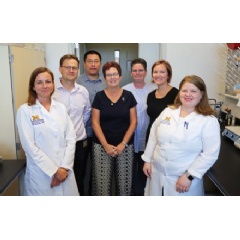Donor family connects gift of eye tissue to vision research
Unique visit to Kellogg Eye Center bridges power of donation and vision research

When Tim Anegon became an eye tissue donor after his death in 2014, it wasn’t just one person he would touch with his eyes – it was millions.
His family got a chance to see that impact in action when they visited the lab of a University of Michigan researcher whose team is putting Tim’s tissue and cells to good use. They got there with the help of the nonprofit group Eversight Michigan (link is external), which focuses on restoring sight and preventing blindness, and is connecting families of individuals who gave the generous gift of eye tissue with researchers working to cure eye diseases.
The family visited with Patrice E. Fort, Ph.D. (link is external), a researcher at the U-M Kellogg Eye Center (link is external), who showed them how Tim’s cells are an invaluable tool in the fight against diabetic eye disease.
“In research, we start with animal models and cell models, but those have limitations,” said Fort, a research assistant professor in ophthalmology and visual sciences at the University of Michigan. “If we want to understand how diabetes affects the human retina, we will find the most meaningful answers with human tissue from eye donation.”
Today more than 32 million people worldwide are blind and another 200 million suffer from moderate to severe visual impairment, according to Eversight.
The gift of eye donation has fueled major advances in understanding blinding diseases such as glaucoma and age-related macular degeneration, but researchers face a shortage (link is external) of human eye tissue as the number of eyes donated for research continues to decline.
Donating hope
Through organ and tissue donation, families donate hope for cures and a second chance at life. And Tim Anegon wasn’t just a donor – he was a recipient too.
When Anegon, of Saginaw Mich., received a liver transplant, his family understood it was only possible because a donor gave the gift of life. He passed away due to complications following the transplant, and his family decided to be an organ donor family.
“He was 50 when he got sick. He had just turned 54 when he passed,” said his wife Coleen Anegon. “He lived a lot of life in those 54 years. He lived well and loved his children.”
Eversight arranged the meeting between the Anegon family and Fort as part of its Hope and Healing program that celebrates the gift of donated eye tissue to research.
“The Hope and Healing program gives families a chance to see the real impact of research donation,” said Colleen Vrba, Eversight research programs manager. “Knowing that your love one’s donation is helping to find therapies and treatments for blinding eye diseases has a tremendous meaning for families.”
The unique and special meetings with researchers also provides pride and empowerment.
“Donating his cornea and eye tissue seemed so insignificant compared to an organ,” said his daughter Courtney Anegon. “But we realize from (the researchers) today that improving someone’s quality of life is huge, in ways that we can’t even begin to understand.”
Bridging donation to vision research
Fort says many of those diagnosed with diabetes will experience some type of issue with their retina during the course of their disease, which causes varying degrees of vision loss.
“They start losing vision at some point, to some degree,” he said. “For some of them it’s going to be complete blindness, for others it’s going to be a little bit more subtle, but all of them virtually will have problems with their vision.”
Eversight is working to increase the number of people who join the donor registry and consent to research to increase accessibility to eye tissue.
At Kellogg, a repository of eye tissue (https://www.ncbi.nlm.nih.gov/pubmed/25789112 -link is external) is being developed to investigate aspects of diabetic retinopathy -- from damage to blood vessels in the eye to inflammation and retinal cell death. The Kellogg research team (http://kellogg.umich.edu/bios/fort.lab.html -link is external) working on the project includes Mandy Losiewicz, Angela Myers, Yang Shan, M.D., M.S., and international visiting scholar Anne Ruebsam, M.D.
The collection will include non-diabetic and diabetic tissue and is expected to be used for years to come.
( Press Release Image: https://photos.webwire.com/prmedia/8/212199/212199-1.jpg )
WebWireID212199
This news content was configured by WebWire editorial staff. Linking is permitted.
News Release Distribution and Press Release Distribution Services Provided by WebWire.